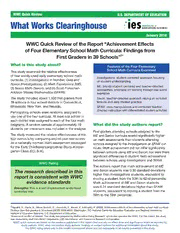
ERIC ED508010: WWC Quick Review of the Report "Achievement Effects of Four Elementary School Math Curricula: Findings from First Graders in 39 Schools" PDF
Preview ERIC ED508010: WWC Quick Review of the Report "Achievement Effects of Four Elementary School Math Curricula: Findings from First Graders in 39 Schools"
WWC Quick Review U.S. DEPARTMENT OF EDUCATION What Works Clearinghouse January 2010 WWC Quick Review of the Report “Achievement Effects of Four Elementary School Math Curricula: Findings from First Graders in 39 Schools”†* What is this study about? Features of the Four Elementary School Math Curricula Examined This study examined the relative effectiveness of four widely-used early elementary school math Investigations: student-centered approach focusing curricula: (1) Investigations in Number, Data and on student understanding Space (Investigations), (2) Math Expressions (ME), ME: blends student-centered and teacher-directed (3) Saxon Math (Saxon), and (4) Scott Foresman- approaches; emphasis on learning through real-world Addison Wesley Mathematics (SFAW). examples The study included about 1,300 first graders from Saxon: teacher-directed approach relying on scripted 39 schools in four school districts in Connecticut, lessons and daily student practice Minnesota, New York, and Nevada. SFAW: uses manipulatives and combines teacher- directed instruction with differentiated student activities Participating schools were randomly assigned to use one of the four curricula. At least one school in each district was assigned to each of the four math programs. A random sample of approximately 10 What did the study authors report? students per classroom was included in the analysis. First graders attending schools assigned to the The study measured the relative effectiveness of the ME and Saxon curricula scored significantly higher four curricula by comparing end-of-year test scores on math assessments than students attending on a nationally normed math assessment developed schools assigned to the Investigations or SFAW cur- for the Early Childhood Longitudinal Study–Kinder- ricula. Math achievement did not differ significantly garten Class (ECLS–K). between schools using ME and Saxon; nor were there significant differences in student math achievement between schools using Investigations and SFAW. WWC Rating The authors report that math achievement of ME The research described in this and Saxon students was 0.30 standard deviations higher than Investigations students, equivalent to report is consistent with WWC moving a student from the 50th to 62nd percentile. evidence standards Math achievement of ME and Saxon students was 0.24 standard deviations higher than SFAW Strengths: This is a well-implemented randomized controlled trial. students, equivalent to moving a student from the 50th to the 59th percentile. † Agodini, R., Harris, B., Atkins-Burnett, S., Heaviside, S., Novak, T., & Murphy, R. (2009). Achievement effects of four elementary school math curricula: Findings from first graders in 39 schools (NCEE 2009-4052). Washington, DC: National Center for Education Evaluation and Regional Assistance, Institute of Education Sciences, U.S. Department of Education. *Absence of conflict of interest: This study was prepared by Mathematica Policy Research, which also operates the WWC. For this reason, the study was reviewed by staff from RAND Corporation, ICF International, and Concentric Research & Evaluation. WWC quick reviews are based on the evidence published in the report cited and rely on effect sizes and significance levels as reported by study authors. WWC does not confirm study authors’ findings or contact authors for additional information about the study. The WWC rating refers only to the results summarized above and not necessarily to all results presented in the study.
